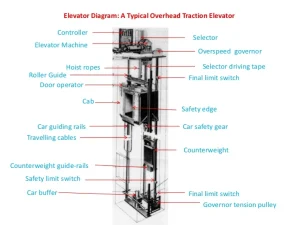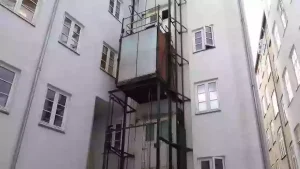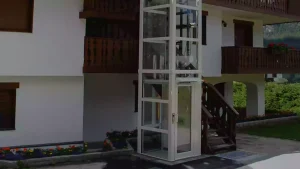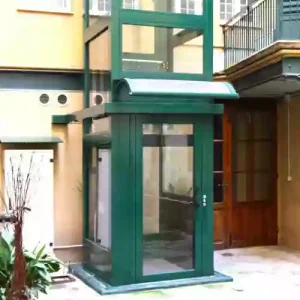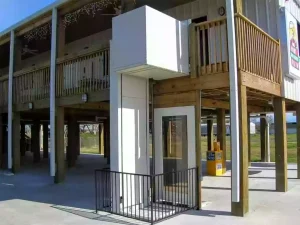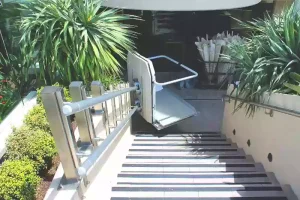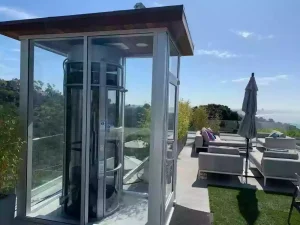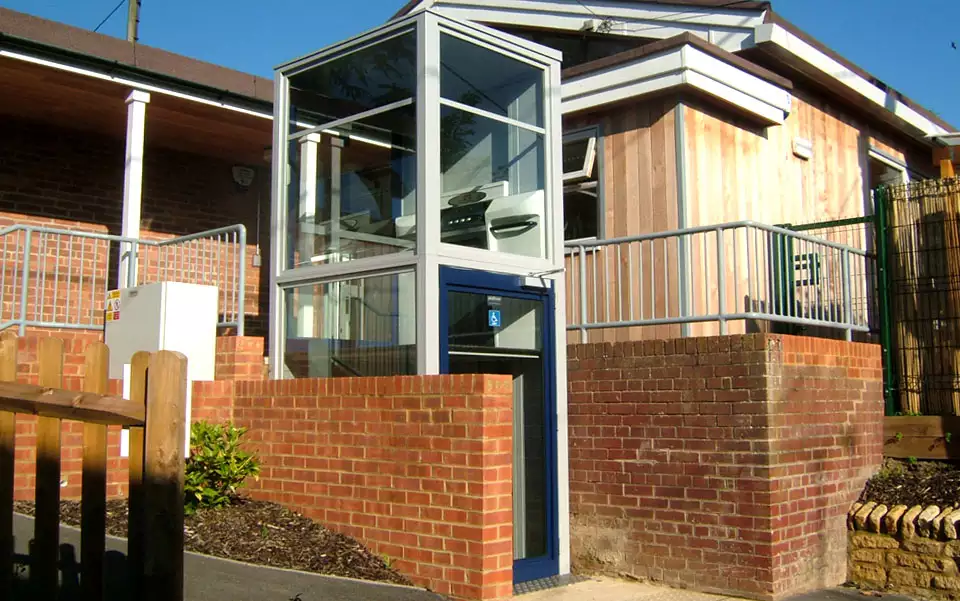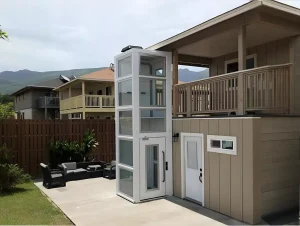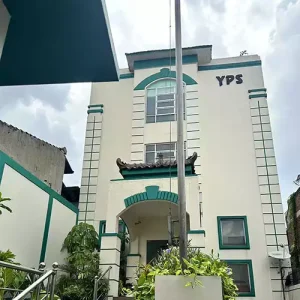There are many types of outdoor residential elevators, and different types of outdoor residential elevators have their own characteristics and are suitable for different building types. If you are planning to install an outdoor residential elevator, please read this article first to make sure that the elevator you choose meets your needs.
What is an Outdoor Residential Elevator and Why is it Recommended?
An outdoor residential elevator is a self-supporting lifting system that saves a lot of infrastructure work, is relatively low-cost, and does not take up valuable indoor space.
An outdoor residential elevator is a lifting system installed on the exterior of a residence to connect floors or entrances such as garages, patios, decks, or hillsides. Unlike indoor elevator systems, outdoor elevators use corrosion-resistant materials, sealed electronics, and structural reinforcement technology to withstand temperature changes, UV exposure, and precipitation.
Common applications:
- Provide mobility support for the elderly or disabled
- Easily transport goods (groceries, tools, luggage)
- Increase property value and comfort in multi-story homes
Types of Outdoor Residential Elevators
Different types of elevators are suitable for different building heights, user needs, and design preferences. Here are some common types of outdoor residential elevators and their respective features:
Hydraulic Outdoor Residential Elevators
Hydraulic systems drive the car through liquid pressure and are suitable for scenarios with a vertical travel of less than 13.7 meters (such as 2-4-story homes). According to a study by the University of Michigan, its energy consumption per operation is only 0.8kWh, and the installation cost is about $30k-$60k. But be aware that outdoor hydraulic elevators are prone to seal aging in humid environments.
- Best suited for: 2-4-story homes that require smooth and quiet operation.
- Pros: Low initial cost, strong load-bearing capacity, simple mechanical structure
- Cons: Slow speed, pit required, high maintenance frequency
Traction Outdoor Residential Elevators
Traction elevators operate through a steel cable and counterweight system, consuming 33% less energy than hydraulic types and saving 28% in life cycle costs. For example, BDFUJI’s outdoor residential elevators use silicon nitride-coated gears, which can operate stably from -30°C to +60°C, significantly reducing maintenance costs in extreme climates.
- Best suited for: mid- to high-rise buildings or longer operating distances.
- Pros: Fast and efficient, energy-saving, glass shaft design, elegant appearance
- Cons: High installation cost, complex shaft requirements
Pneumatic Outdoor Residential Elevator
Pneumatic elevators do not require shafts, rely on air pressure differences to operate, and cost $40k-$80k to install. However, their high-pressure sealing system is sensitive to moisture, and the annual maintenance fee can reach $800+. It is more suitable for areas with drier climates (such as Arizona).
- Best for: Modern homes that need a compact pitless solution.
- Pros: No shaft or pit required, easy installation, space saving
- Cons: Limited to 3-4 stops, high cost, small car
Platform Outdoor Elevator
Vertical Platform Lift (VPL) costs only $15k-$25k and is suitable for single-story wheelchair users. But be aware: its load is usually limited to less than 500 pounds, and the waterproof cover seal needs to be checked regularly.
- Best for: Wheelchair access between terrace and main floor
- Pros: Affordable, simple, ADA compliant
- Cons: Weather-sensitive, slow, unsightly
Outdoor Stair Lift (Not a Full-featured Elevator,But a Common Alternative)
Stair lifts are relatively inexpensive, costing only $5,000 to $12,000, but the metal tracks can become slippery in rainy or snowy weather.
- Best for: Budget-conscious users who already have stairs.
- Pros: Low cost, quick installation
- Cons: Not wheelchair-friendly, low load-bearing, susceptible to rain
What is The Average Cost of Various Types of Outdoor Residential Elevators?
Different types of outdoor residential elevators, operating heights, and functional costs vary, and here is the cost range for each type of elevator.
Type Average Cost ($) Notes
| Type | Average Cost (USD) | Notes |
|---|---|---|
| Hydraulic | $35,000 – $55,000 | Most common, excellent for low-rise |
| Traction | $45,000 – $70,000 | Smooth ride, higher upfront investment |
| Pneumatic | $50,000 – $80,000 | No pit required, premium design |
| Platform Lift | $15,000 – $30,000 | Basic mobility support, exposed frame |
| Outdoor Stair Lift | $3,000 – $7,000 | Chair only, limited mobility coverage |
Factors Affecting the Cost of Outdoor Residential Elevators
| Factor | Description | Influence Level |
|---|---|---|
| Shaft/Structure Work | Concrete, steel frame, weatherproof enclosure | ★★★★☆ |
| Elevator Equipment | Drive type, safety tech, control systems | ★★★★★ |
| Customization | Glass doors, lighting, voice control, finishes | ★★★☆☆ |
| Labor & Region | Local wage levels, installer availability | ★★★☆☆ |
| Permit & Compliance | Building permits, ADA/code requirements | ★★☆☆☆ |
| Post-install Services | Maintenance contract, remote monitoring options | ★★☆☆☆ |
Which Elevator is Best for My Home?
Your ideal elevator depends on your home’s structure, environment, and user needs.
According to building type
Single-family home or villa:
Choose a hydraulic or pneumatic elevator for both aesthetics and structural flexibility.
Home on a slope or hillside:
Use a traction elevator or heavy-duty platform lift to cover vertical distances.
Harsh climate (coastal areas, snow):
BDFUJI recommends enclosed hydraulic models with IP-rated motors and corrosion-resistant frames.
According to The Field Data
Choosing the right lift is like choosing the right car, just like you wouldn’t drive a commercial vehicle in the mountains. So please choose the right type of outdoor residential lift based on the terrain and load.
You can also choose the type of residential elevator that better fits your site, here’s what you do:
Site Assessment
Evaluate the available outdoor space, ride height, and ground conditions professionally.
Is there enough space to install a shaft or platform? Can a pit be used?
System Selection
Choose a hydraulic, traction, pneumatic, or platform lift system based on the following factors:
Ride height
- Desired features (glass enclosure, soft start/stop, remote access)
- Local climate and maintenance capabilities
- Structural compatibility and measurements
- Take precise measurements (shaft dimensions, platform dimensions, entry points), and assess if modifications are needed (walls, foundation, drainage).
You can also consult with manufacturers such as BDFUJI who provide structural CAD support and custom solutions.
Installation Considerations and Maintenance Needs
Site preparation, weatherproofing measures, and maintenance affect cost and performance.
Installation Includes:
- Foundation pouring or anchor point preparation
- Power supply and control panel setup
- Weatherproof sealing and drainage solutions
Maintenance Typically Includes:
- Annual inspection of hydraulic oil or cable tension
- Inspection of seals, doors, and electrical systems
- Costs range from $300 to $800 per year
Monthly Outdoor Elevator Maintenance Checklist
| Task | What to Do |
|---|---|
| Guide Rail Cleaning | Remove debris, dust, and moisture from the guide rails to ensure smooth operation. |
| Seal Inspection | Check door and shaft seals for cracks, aging, or detachment to maintain waterproofing. |
| Drainage Check | Ensure that pit and floor drains are free of blockages, especially after heavy rain or snow. |
| Control Panel & Motor Room Check | Listen for unusual noises; inspect for signs of corrosion, overheating, or wear in electrical components. |
Choosing an outdoor residential lift requires a comprehensive assessment based on budget, usage scenarios, and climate conditions. As long as you choose well. Whether you are planning to age in place, assist family members, or just upgrade your property, outdoor residential lifts can provide practical and long-term benefits. With a trusted brand like BDFUJI, making the right choice is easier. BDFUJI combines engineering expertise, durable outdoor-grade materials, and global certifications (CE, EAC, ISO) to provide you with outdoor lifts that are built to last.



